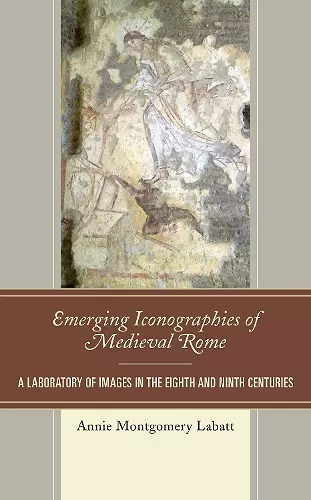Emerging Iconographies of Medieval Rome
A Laboratory of Images in the Eighth and Ninth Centuries
Annie Montgomery Labatt author
Format:Paperback
Publisher:Lexington Books
Published:15th Jun '21
Currently unavailable, and unfortunately no date known when it will be back
This paperback is available in another edition too:
- Hardback£108.00(9781498571159)

This book explores the innovative Christian iconographies of early medieval Rome, challenging traditional views that diminish its artistic contributions. Emerging Iconographies of Medieval Rome reveals a vibrant cultural landscape.
In Emerging Iconographies of Medieval Rome, the author delves into the rich tapestry of Christian iconography that flourished in Rome during the eighth and ninth centuries. This study highlights four distinct iconographical forms: the Anastasis, the Transfiguration, the Maria Regina, and the Sickness of Hezekiah. These forms, often categorized as 'Byzantine' by mid-twentieth-century scholars, are re-examined through a fresh lens, emphasizing their experimental nature and the artistic vibrancy of early medieval Rome.
Annie Montgomery Labatt challenges the prevailing narrative that positions Rome as a mere offshoot of Eastern artistic traditions. Instead, she posits that these iconographies represent a significant phase of creativity and innovation, showcasing Rome's role as a vital center for artistic development. By combining formal and stylistic analyses with insights from patristic writings and early medieval thinkers, Labatt reconstructs a more nuanced understanding of this period.
Emerging Iconographies of Medieval Rome not only seeks to reclaim the artistic legacy of a vibrant Rome but also encourages readers to appreciate the complexity of its iconographic experimentation. This book serves as a vital resource for those interested in the evolution of Christian imagery and the cultural dynamics of medieval Europe, revealing a Rome that is rich in creativity and historical significance.
Emerging Iconographies provides a survey of innovative iconographic themes in eighth- to ninth-century century Rome, an era when many major images were not yet standardized. Labatt (visual arts, Sweetbriar College) focuses on four case studies, all with differing trajectories. The Anastasis, later synonymous with Byzantine depictions of the Resurrection, actually had its origins earlier in Rome and then fell out of favor in the West. The Transfiguration, in contrast, was subject to various experimental renderings, “good tries” that often did not become the norm. The bejeweled Maria Regina was a new Western image; it never appeared in the East and soon disappeared in the West. Finally, Hezekiah in his sickness turning his face away from the viewer was depicted just once. Labatt is concerned with the evolution of images, their repetition, variation, and occasional dead ends. Synthesizing and critiquing the complex and conflicting scholarship in this field, she counters the traditional view that Western art is always dependent on Byzantium. Instead, she argues for the fertility of Roman image-making, building on its vibrant early Christian past, and turns from stylistic or political arguments to consider issues of religious belief in the period. Summing Up: Recommended. Upper-division undergraduates through faculty.
* CHOICE *Annie Montgomery Labatt’s insightful reflections break new ground in how scholars should think about Rome in the Early Middle Ages and invite us to the possibility of evolutionary thinking in the study of the development, life, clustering, and afterlives of Christian iconographies. Labatt offers a close analysis of the earliest surviving examples of these different iconographies, which have traditionally been called proto-Byzantine, and shows how their Roman presence is essential. In so doing, the book provides an innovative look at the artistic vibrancy of Rome as a fertile design landscape that allowed varied and vital evolutionary experimentation; that’s why this study is relevant and different. -- Grazia Maria Fachechi, Urbino University
In this beautifully-written work, Labatt situates Rome’s artistic heritage at the heart of dynamic and creative conversations on image-making across the greater Mediterranean world. It offers readers—from beginners in the field to advanced scholars, as well as general audiences, all fascinated with the history of the faith—a profound consideration of the Christian art of the early medieval city. Through concise and thoughtfully-composed case studies, Labatt traces how Constantine’s first capital witnessed fascinating evolutionary experiments that led to a new Christian imagery of the Middle Ages. The ‘marketplace of images’ that Labatt explores so beautifully here is one where Rome’s unique contexts shed further light and inspire our greater curiosity for the distinct visual character of the city and that of Byzantine Constantinople, the new Rome. -- Sarah Brooks, James Madison Univer
ISBN: 9781498571173
Dimensions: 218mm x 152mm x 26mm
Weight: 653g
378 pages